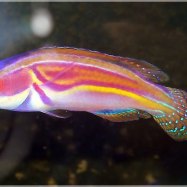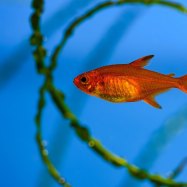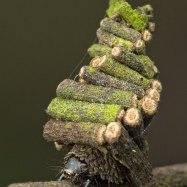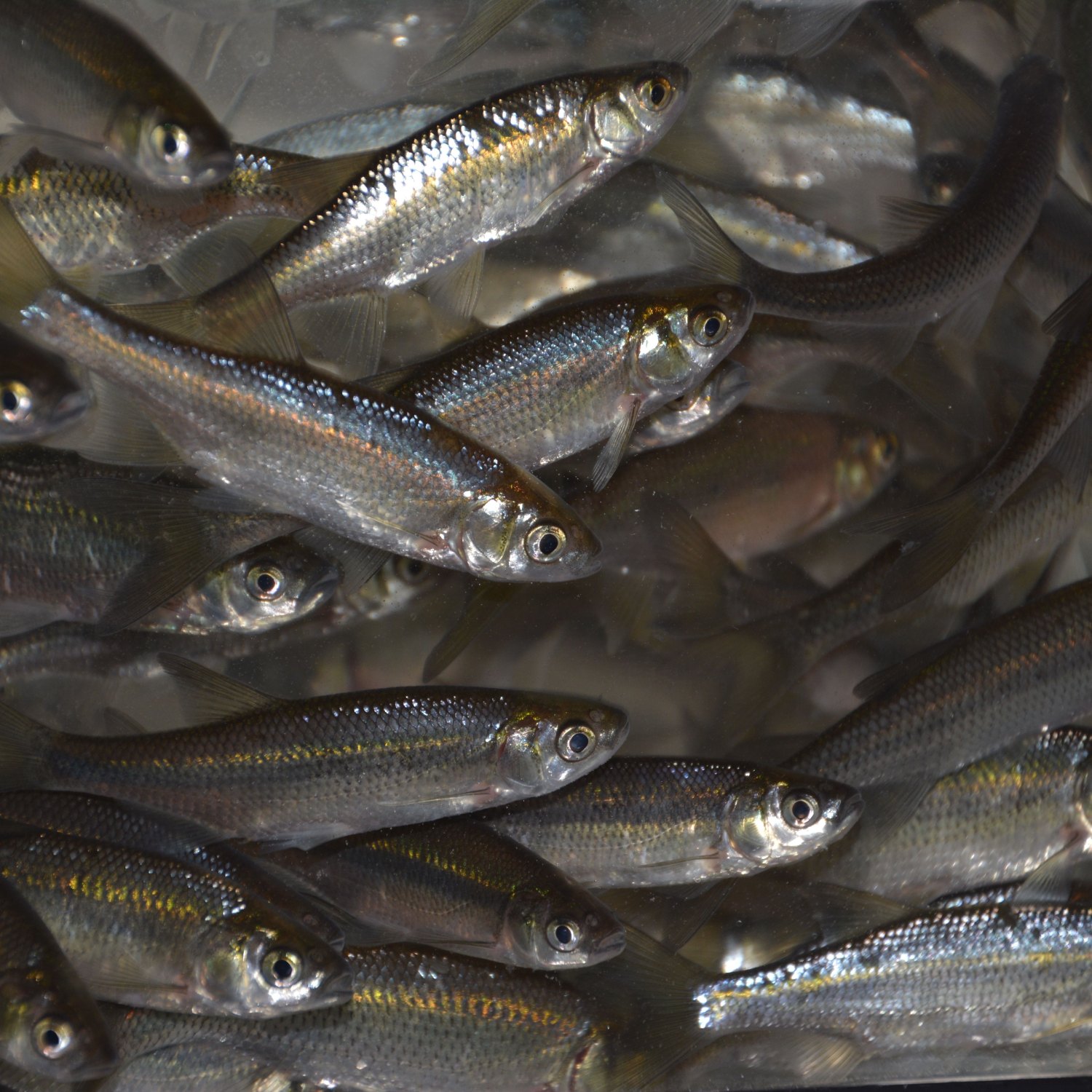
Golden Shiner
Up to 6 inches (15 cm)
The Golden Shiner, also known as the golden minnow, is a small but mighty fish found in ponds, lakes, and slow-moving rivers. They reach up to 6 inches in length and have a slender, laterally compressed body. Belonging to the family Cyprinidae, they are popular among anglers for their fast speed and bright golden color. Keep an eye out for these little swimmers on your next fishing trip! #GoldenShiner #Fishing #Cyprinidae
Animal Details Summary:
Common Name: Golden Shiner
Kingdom: Animalia
Habitat: Freshwater
The Golden Shiner: The Golden Jewel of North America's Freshwaters
For centuries, North America has been home to a wide variety of aquatic creatures, and among them is the Golden Shiner, with its scientific name Notemigonus crysoleucas. This golden-hued fish has captured the hearts and minds of many with its unique appearance and behavior. In this article, we'll dive into the world of the Golden Shiner, exploring its habitat, physical characteristics, diet, and more.The Kingdom of the Golden Shiner
The Golden Shiner belongs to the Animalia Kingdom, a vast group of living organisms that includes all animals Golden Shiner. They are also a part of the Chordata Phylum, a classification that includes all animals with a backbone or spinal cord.A Member of the Cyprinidae Family
The Golden Shiner is a member of the Cyprinidae family, also known as the "carp family." This family of fish is widespread, with over 3,000 species living in freshwater habitats across the world. These fish are known for their slender, torpedo-shaped bodies and their preference for living in groups.The Actinopterygii Class
Actinopterygii is a class of fish that includes most of the world's fish populations. This class is characterized by their bony skeletons and the presence of fins supported by bony or cartilaginous rays. The Golden Shiner belongs to this class, along with 95% of all fish species.The Order of Cypriniformes
The Golden Shiner is a member of the order Cypriniformes, the largest order of freshwater fish in the world. This group includes carp, minnows, and loaches, among others Ghost Crab. The Golden Shiner's placement in this order reflects its evolutionary history and physical characteristics.Aquatic Habitat and Distribution
The Golden Shiner is native to North America, specifically the United States. They are commonly found in the country's freshwater bodies, including ponds, lakes, and slow-moving rivers. These fish thrive in quiet, vegetated habitats with abundant food sources.The geographic distribution of the Golden Shiner extends throughout North America, from as far north as Canada to as far south as Mexico. They can also be found in parts of Central America, but their presence in these regions is believed to be due to human intervention.
The Golden Shiner's Appearance
As the name suggests, the Golden Shiner is known for its beautiful, gold-colored scales. However, these fish are not entirely golden; their body's primary color is silver with a golden to greenish tint, which is most prominent on their sides. They also have a darker, olive-colored back and a white belly. This coloration helps them blend into their freshwater habitats, making them difficult for predators to spot.The Golden Shiner has a slender and laterally compressed body, which is an adaptation that allows them to move swiftly through the water. They have a cylindrical shape, with a pointed head and a small mouth. Their eyes are dark and relatively large, giving them excellent vision.
The Length of the Golden Shiner
On average, Golden Shiners can grow up to six inches in length, or 15 centimeters. However, this can vary depending on the quality of their habitat and access to food. Some Golden Shiners have been recorded to grow up to eight inches long, with a maximum recorded length of 12 inches. However, these are rare, and most Golden Shiners do not exceed the six-inch mark.Omnivorous Diet
Golden Shiners are omnivorous, meaning they eat both plant and animal matter. They have small, pointed teeth, which they use to feed on insect larvae, small invertebrates, and plant matter such as algae and aquatic plants. Their diet plays a vital role in maintaining the balance of their aquatic habitats, as they consume excess vegetation and help control the populations of smaller aquatic organisms.Unique Behavior and Adaptations
Golden Shiners are known for their unique schooling behavior. These fish prefer to live in large groups, ranging from dozens to hundreds of individuals. They use this group behavior as a survival tactic, making it challenging for predators to single out individual fish. Schools also provide better protection and increase the chances of survival.Interestingly, Golden Shiners also have the ability to produce sounds. They create these sounds by rubbing their pharyngeal teeth together, which is a behavior unique to their species. It is believed that these sounds are used as communication signals between individuals.
Another interesting adaptation of the Golden Shiner is their ability to thrive in low-oxygen environments. This is made possible by their special air bladder, which they use to gulp air from the surface of the water. This air serves as a supplemental oxygen source, allowing them to survive in stagnant or low-oxygen waters.
Human Interaction
Golden Shiners are a popular fish among anglers, thanks to their impressive fighting abilities. They are also a vital source of food for larger fish, making them a popular bait choice. However, the fishing of Golden Shiners is closely monitored to ensure sustainable populations.Moreover, due to their schooling behavior, Golden Shiners are often used as "dither fish" in aquariums. These are fish that are kept in aquariums with aggressive species to help reduce aggression and create a more natural social dynamic.
The Importance of Conservation
Despite their widespread presence in North American freshwater habitats, Golden Shiners face various threats, such as pollution, overfishing, and habitat destruction. As such, it is essential to preserve their natural habitats and regulate their fishing to ensure the sustainability of their populations.The Golden Shiner is a crucial part of the aquatic ecosystem, playing a crucial role in maintaining the balance of their habitats. Their beautiful appearance, unique behavior, and important ecological role make them a cherished fish among many. As we continue to learn more about these "golden jewels" of our freshwater bodies, it is important to work towards preserving their populations for generations to come.

Golden Shiner
Animal Details Golden Shiner - Scientific Name: Notemigonus crysoleucas
- Category: Animals G
- Scientific Name: Notemigonus crysoleucas
- Common Name: Golden Shiner
- Kingdom: Animalia
- Phylum: Chordata
- Class: Actinopterygii
- Order: Cypriniformes
- Family: Cyprinidae
- Habitat: Freshwater
- Feeding Method: Omnivorous
- Geographical Distribution: North America
- Country of Origin: United States
- Location: Ponds, lakes, and slow-moving rivers
- Animal Coloration: Silver with a golden to greenish tint
- Body Shape: Slender and laterally compressed
- Length: Up to 6 inches (15 cm)

Golden Shiner
- Adult Size: 4-6 inches (10-15 cm)
- Average Lifespan: 3-4 years
- Reproduction: Spawning
- Reproductive Behavior: Egg scatterers
- Sound or Call: No specific sound or call
- Migration Pattern: Some populations exhibit short-distance migrations
- Social Groups: Schooling
- Behavior: Active and fast-swimming
- Threats: Habitat loss, pollution, predation
- Conservation Status: Least Concern
- Impact on Ecosystem: Important prey species
- Human Use: Fishing bait, aquarium trade
- Distinctive Features: Golden coloration, slender body
- Interesting Facts: Golden Shiners are a popular baitfish for fishing.
- Predator: Predated by larger fish and birds of prey
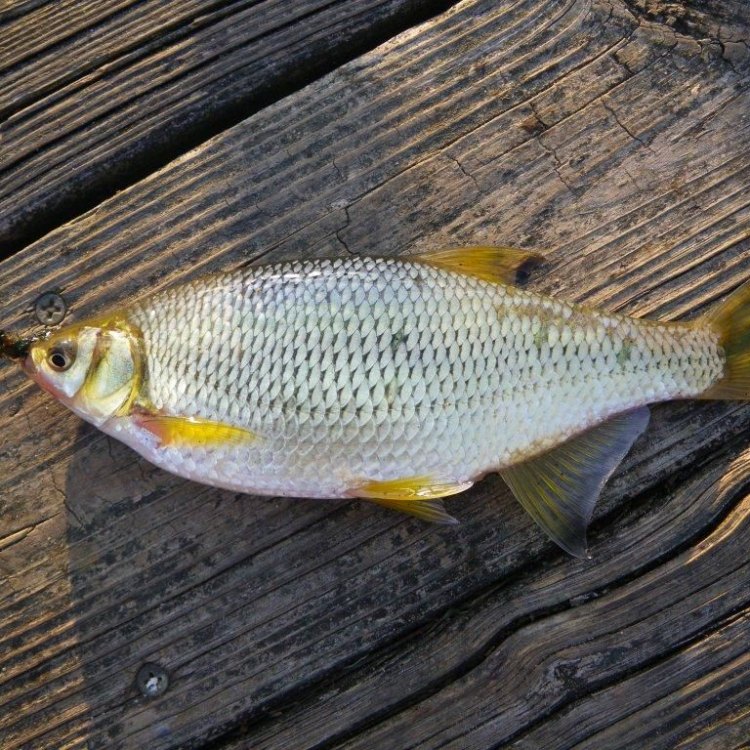
Notemigonus crysoleucas
The Golden Shiner: A Unique and Versatile Fish
The Golden Shiner, also known as the Notemigonus crysoleucas, is a small and slender fish with a distinctive golden color. Despite its size, this fish holds a significant place in many ecosystems and human activities. From being a crucial prey species to a popular baitfish for fishing, the Golden Shiner is a versatile and fascinating creature that deserves recognition.This article aims to shed light on the unique features, behavior, and role of the Golden Shiner in its environment PeaceOfAnimals.Com. From its physical appearance to its impact on ecosystems and human use, we will delve into the world of this intriguing fish.
A Closer Look at the Golden Shiner
The Golden Shiner is a small fish, measuring between 4-6 inches (10-15 cm) in length. They have a slender and elongated body, which is characteristic of the Cyprinidae family to which they belong. Their scales are silvery, but their name comes from the distinctive golden coloration on their sides, giving them a bright and shimmering appearance.Golden Shiners are native to North America, specifically the United States and Canada, and can be found in various freshwater habitats such as ponds, lakes, and slow-flowing streams. They prefer to live in shallow water near vegetation, where they can find food and protection from predators.
The Golden Shiner's Reproduction and Behavior
Like most fish, Golden Shiners reproduce through spawning, which is the process of releasing and fertilizing eggs. However, what makes them unique is their reproductive behavior. They are known as "egg scatterers" because they do not guard or protect their eggs or young ones Gray Catbird. Instead, the female lays hundreds of eggs near aquatic vegetation, and the male fertilizes them externally.Golden Shiners, like most fish, do not communicate through sound or calls. However, they do exhibit social behavior in the form of schooling. Schooling is when a group of fish swims together in a coordinated manner. This behavior is commonly seen in fish that live in open water, and it serves as a defense mechanism against predators.
These fish are also quite active and fast-swimming, constantly moving to find food and stay safe. This behavior makes them harder to catch for predators and adds to their unique characteristics.
The Golden Shiner's Role in the Ecosystem
The Golden Shiner plays a crucial role in many freshwater ecosystems. As an important prey species, they are food for a variety of larger fish, such as bass and pike, as well as birds of prey such as herons and ospreys. Their presence in a water body supports the growth and survival of these predators, making them essential for maintaining a balanced ecosystem.Additionally, Golden Shiners are also important for nutrient cycling. As they feed on aquatic plants and insects, they contribute to the breakdown of organic matter, which helps in the circulation of oxygen and essential nutrients in the water.
Challenges and Conservation Status
Like many other aquatic species, the Golden Shiner faces several threats to its survival. Habitat loss, pollution, and predation by invasive species are some of the major challenges that these fish have to endure. The destruction of wetlands and the alteration of water bodies greatly reduce the availability of suitable habitats for Golden Shiners.Pollution from industrial and agricultural activities can also have a significant impact on these fish. Chemicals and toxins can contaminate the water and disrupt the delicate balance of the ecosystem. This can lead to changes in the behavior, growth, and reproductive abilities of Golden Shiners, affecting their population and ultimately their survival.
Another threat to Golden Shiners is predation by invasive species. These invasive predators, such as the European Rudd, can outcompete native fish for resources and prey on Golden Shiners, reducing their population size.
However, despite these challenges, the Golden Shiner is currently listed as "Least Concern" on the IUCN Red List of Threatened Species. This means that their population is stable, and they are not at high risk of extinction. Nonetheless, it is essential to continue monitoring and conserving these fish, as their well-being is crucial for the health of freshwater ecosystems.
Human Use of Golden Shiners
Aside from their role in the ecosystem, Golden Shiners also have value for humans. They are popular baitfish for fishing, particularly for gamefish such as bass and trout. Their small size, active behavior, and golden color make them enticing to larger fish, making them a highly sought-after bait.Furthermore, Golden Shiners are also commonly kept in aquariums. Due to their bright and shimmering appearance, they add a touch of color and liveliness to any tank. However, it is important to note that these fish require specific care and should not be released into the wild after being kept in captivity.
Interesting Facts About Golden Shiners
- Golden Shiners are a popular baitfish for fishing, but they are also important for scientific research as they are easy to breed and maintain in a laboratory setting.- In the wild, Golden Shiners can live up to 3-4 years, but in captivity, they can live up to 12 years.
- Despite their small size, Golden Shiners have a wide geographic range, and they can be found in 41 of the 50 US states.
- These fish have a unique adaptation known as the "lateral line system." This system helps them detect vibrations in the water, allowing them to navigate and communicate with other fish.
- Golden Shiners are sensitive to changes in temperature and water quality, making them excellent indicators of the overall health of a water body.
The Predator of the Golden Shiner
Being a prey species, Golden Shiners are naturally preyed upon by larger fish and birds of prey. One of their main predators is the Largemouth Bass, a popular gamefish known for its sharp teeth and large mouth. Other predators include Northern Pike, Muskie, and even herons and kingfishers.Despite being a prey species, Golden Shiners have a few ways to protect themselves from predators. The first is their schooling behavior. By swimming in a group, they are harder to catch as there are more targets for the predator to focus on.
Additionally, Golden Shiners have the ability to rapidly change direction and speed, making it challenging for predators to catch them. They can also hide in dense vegetation, which provides them with shelter and protection.
In Conclusion
The Golden Shiner, with its unique appearance, behavior, and role in the ecosystem, is a remarkable fish that deserves recognition and appreciation. From being an important prey species to a popular baitfish for fishing, this small and humble fish plays a significant role in balancing and maintaining the health of freshwater ecosystems.As with all creatures in nature, it is crucial to protect and conserve the Golden Shiner's habitats to ensure their survival for future generations. Their shiny and golden presence in our waters is a reminder of the diversity and beauty of the natural world.
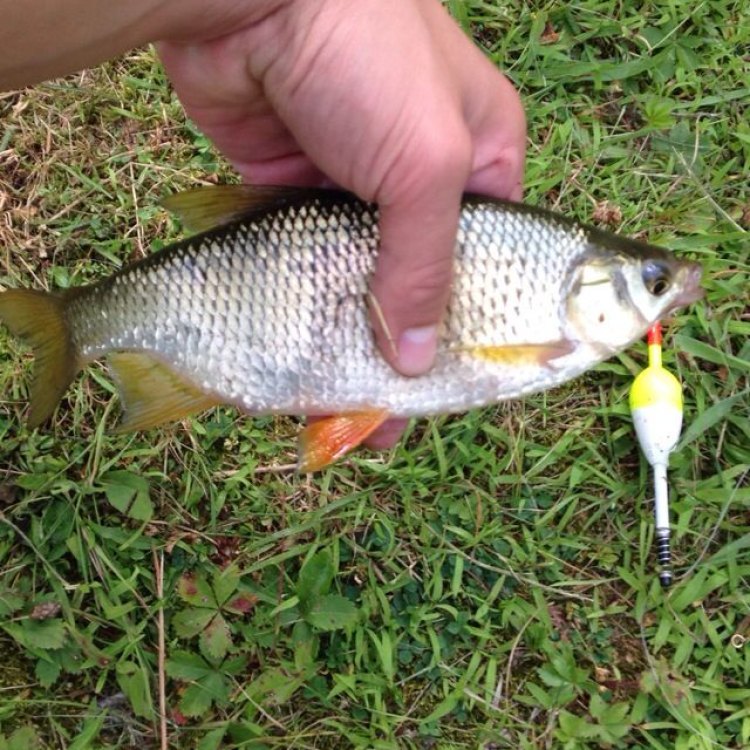
The Golden Shiner: The Golden Jewel of North America's Freshwaters
Disclaimer: The content provided is for informational purposes only. We cannot guarantee the accuracy of the information on this page 100%. All information provided here may change without prior notice.






